Throne of Blood, directed by Akira Kurosawa
Review of its structure
Throne of Blood (aka Spider Web Castle) is a Japanese movie version of Shakespeare’s Macbeth, made in 1957 by the great director Akira Kurosawa, set in medieval Japan. It is a highly structured film, heavily influenced by Japanese Noh drama conventions.
Washizu (played by Toshiro Mifune) is the Macbeth character. Asaji (Isuzu Yamada) is Lady Macbeth. Miki (Minoru Chiaki) is the Banquo figure. The Great Lord is Duncan, i.e. the murdered king. Noriyasu (played by Takashi Shimura) has no direct counterpart, perhaps a mix of Macduff and Siward. To be sure, “Throne of Blood” contains significant variations from “Macbeth;” there’s only one witch; Washizu does not die in one-on-one combat; Asaji announces she is with child. And more.
The overall movie is framed with a prelude and postlude. And within the movie, there are four acts, with breaks between noted by three seconds of empty black screen. All of Kurosawa’s transitions are breaks are fun to observe at home, with a DVD that you can pause, rewind, and fast-forward.
PRELUDE
After the credits, the movie opens with a chanted hymn, about the desolation of Spider Web Castle, a barren, foggy scene gradually zooming in on a simple wooden memorial pillar. The fog intensifies until the screen is almost wholly gray; gradually the murkiness thins out enough to let us see a long shot of Spider Web Castle. (Criterion Collection Chapter 1) This sequence (Chanting –> Pillar –> Total Gray –> Castle) is reversed at the end of the movie.
ACT I – RISE OF WASHIZU
Day
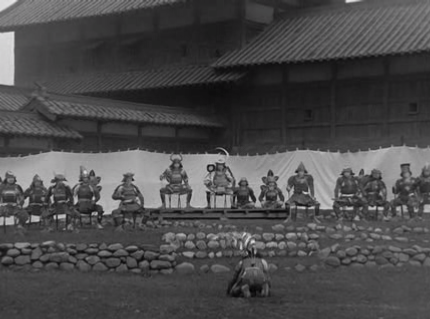
Opens with a messenger riding up to the castle, carrying news of a battle to the Great Lord. The assembled officers discuss this news, which turns positive. Washizu and Miki, the two authors of the victory, are summoned. (Criterion Collection Chapter 2)
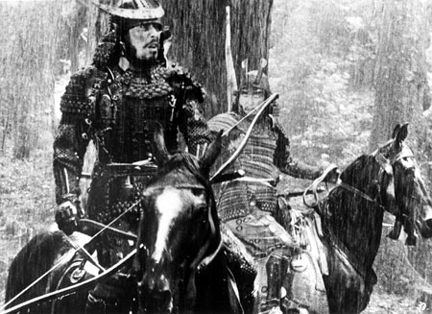

Washizu and Miki ride, disoriented, in the forest, encountering the witch, who delivers her prophecies. (Ch. 3 and 4) Washizu and Miki get lost in the fog, but eventually find Spider Web Castle. (Ch. 5)
Night
An evening ceremony closes the act, as the Great Lord rewards Washizu and Miki with promotions, fulfilling the first part of the witch’s prophecies. (Ch. 6)
While the day/night structure is quite pronounced throughout, by no means are such segments of equal duration.
Act I ends with an entirely black screen, lasting 2 to 3 seconds.
ACT II – MURDER OF GREAT LORD
Day
Opens with a chorus, four men commenting on the general state of affairs. Here, at this point, they say that everything is about perfect. Indeed the sun is shining, a rare event in the film, and peasants are tending the fields in front of North Castle, now commanded by the newly promoted Washizu. A horse is led placidly around; horses often signify the mood. Soon, Washizu and his wife, Asaji, confer, and the plotting to kill the Great Lord begins. The Great Lord visits. (Ch. 7 and 8)
Night
This scene unfolds deliberately, filling Chapters 9, 10, and 11. (Criterion’s chapter breaks are useful and well-placed, but, of course, are not Kurosawa’s own designations.) The Great Lord is killed off-screen; Asaji washes her hands for the first time. We hear the squeaky silk of her costume as she shuffles across the floor. On screen, we do see Washiki kill one of the hapless, drugged guards.
The spare interior set, the costumes, and the stylized acting are reminiscent of Noh drama, but I don’t know enough about Noh to comment very much about this aspect.
Day
A rousing battle, typical of Kurosawa, as in The Seven Samurai, opens this scene. Washizu chases Noriyasu and the Prince to the gates of Spider Web Castle, now overseen by Miki. The two alleged conspirators are turned away, while the real murderer, Washizu, is admitted, bearing the coffin of the Great Lord.
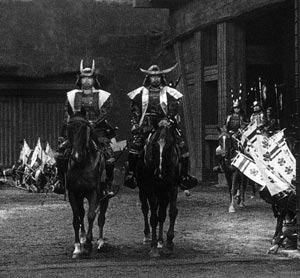
With wonderful facial attitudes, Miki reveals he knows the truth, but he will support Washizu, as political reality requires. (Ch. 12, 13)
A close-up of the Great Lord’s coffin and pall-bearers, another ceremony, ends this scene and act.
Fade to black again, separating Acts II and III.
ACT III – MURDER OF MIKI
Day
A chorus opens, this time the men are a little concerned. “If only this house had an heir …” More wind and fog. Washizu and Asaji talk; she pushes him to do away with Miki. (Ch. 14)
A horse is wildly raging, absolutely mad; it is Miki’s horse. Uh-oh. (Ch. 15)
Night
This night opens briefly with a chorus too, although not the beginning of an act. Miki’s horse returnless, riderless. Not a good sign, but brief, and easy to overlook.
This scene is devoted to a formal dinner (another ceremony) in Miki’s honor, but the guest of honor is missing, killed by Washiki’s henchman. Washizu sees Miki’s ghost, a very close parallel to Macbeth seeing Banquo’s ghost. Angered that the henchman let Miki’s son escape, Washiku runs him through, on screen. (Ch. 16)
Once again, we have a black screen for 2 – 3 seconds to close the act.
ACT IV – FALL OF WASHIZU
Day
A chorus opens; this time they are really worried. The wind seems to shake the foundations of heretofore impregnable Spider Web Castle. Asaji is sick. Once again, messengers come riding in, reporting of losses to rebels. Washizu berates his officers. (Ch. 17) And then, rides off in the rain to consult the witch; this time he doesn’t get lost in the forest at all. (Ch. 18)
In only the second bit of sun in the movie, we see Noriyasu’s massed army attacking. Washizu tries to rally his men, citing his confidence based on the witch’s prophecy. (Ch. 19)
Night
That night the defenders hear the attackers chopping the trees. Birds swarm into Washizu’s council room. (Ch. 20)
Day
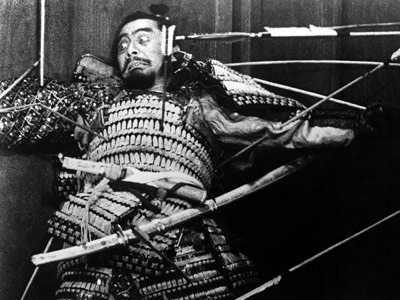
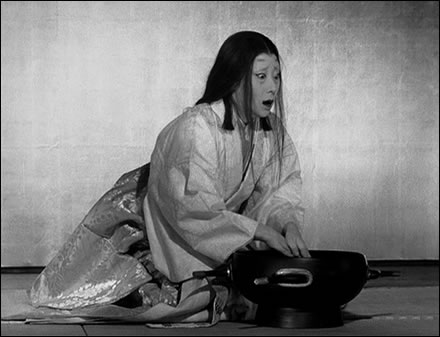
Asaji madly washes her hands in vain. Fulfilling the prophecy, the forest itself advances and Washizu’s own men kill him, porcupining him with arrows. Noriyasu’s men advance, using the trees and branches for cover. (Ch. 21, 22)
This image flows right into the postlude.
POSTLUDE
The last action scene of the movie shows the forest/army advancing on Spider Web Castle. Then, the Prelude (Chanting –> Pillar –> Total Gray –> Castle) is reversed. The castle fades to gray; we see the pillar; and then the chanting hymn continues.
TWOS, DOUBLES, PAIRS, AND DUALITIES
If Rashomon is all about three, Throne of Blood is all about two. i hasten to suggest that ‘two’ does not signify good and evil. If you want to get into such values, then I might try ‘evil’ and ‘more eviller,’ but I probably wouldn’t go there at all.
At any rate, there are lots of pairs, lots of events that are repeated, with a different sense, of course.
Washizu visits the witch twice.
There are two murders. (Actually four, since each nobleman is killed off-screen, while some inconsequential nobody is killed on-screen in both cases.)
Washizu is one member of: a husband/wife pair, a pair of friends, a pair of Great Lords. (He is appointed to the office.)
Two castles (North and Spider Web) are the only two locales of the movie. It is repeatedly made clear that the labyrinthine forest is a part of Spider Web Castle’s outer defenses.
Washizu gives two speeches to his men
.
Twice we see riders and messengers reporting to a Great Lord about a rebellion. Asaji washes her hands twice.
And, of course, most explicitly, the end of the movie is the same as the beginning.
Rather than seeking some mystical significance in the number two, I’d suggest that, in this highly structured film, Kurosawa repeats many scenes that he wants us to think about, in comparison to the earlier scene. For example, at the opening of Act II, when things are looking up, there’s a fairly lengthy shot of a horse calmly being walked around the courtyard of North Castle. But, in Act III, Miki’s horse, in the same courtyard, rampages madly and wildly. The repetition creates contrast.
Other Notes – Things to Watch for
Most of the movie is cloudy, foggy, windy, and/or rainy.
Listen for a few key sound effects: the loud creaking of the gate, the exaggerated banging of the fists on the gate, Asaji’s silk outfit squeaking on the floor, crows cawing (symbol of death in Japan), Washizu’s nervous clicking fan as he sits with Asaji.
Watch the galloping riders, seen through the foreground branches.